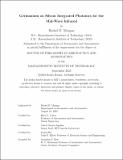Germanium on Silicon Integrated Photonics for the Mid-Wave Infrared
Author(s)
Morgan, Rachel E.
DownloadThesis PDF (23.29Mb)
Advisor
Cahoy, Kerri L.
Terms of use
Metadata
Show full item recordAbstract
This thesis presents the development of a Germanium-on-Silicon (GOS) integrated photonics platform for the mid-wave infrared (MWIR) wavelength range. Integrated photonics applies nanofabrication approaches with optical materials in order to miniaturize and improve the robustness of optical systems. Most integrated photonics development occurs in the near-infrared for telecommunications applications, but there is increasing interest in expanding the technology to other wavelength ranges. The MWIR wavelength range has applications in environmental sensing, industrial monitoring, and communications. This work develops low-loss waveguides, a passive component library, integrated modulators, laser integration design, and systems analysis
for the 2-5 µm wavelength range.
Low-loss waveguides are demonstrated with losses of 0.6-2.5 dB/cm without top cladding. A detailed study of top cladding materials is conducted including niobium pentoxide, hafnium dioxide, epitaxial silicon, and others. Of these materials, niobium pentoxide offers the best performance with measured losses as low as 3.49±0.3 dB/cm.
A passive component library is designed based on waveguides with and without top cladding, developing building-block components such as couplers, splitters, ring resonator filters, and Mach-Zehneder interferometers. Air-clad ring resonators demonstrate narrow-bandwidth filtering with a recorded extinction ratio of >20 dB, full-width half max (FWHM) of 0.7 GHz, and unloaded Q factor of >190,000.
Integrated phase shifters are designed based on the plasma-dispersion effect and the thermo-optic effect. A plasma dispersion effect modulator is designed for forward-bias operation at 4.6 µm wavelength with predicted half-wave voltage (V subscript 𝜋) of 0.5 V, length (L) of 525 µm, voltage-length product (V subscript 𝜋L) of 0.027 V·cm, and speed of 58.4 MHz. A reverse-bias plasma dispersion effect modulator at 4.6 µm wavelength is designed with predicted V subscript 𝜋 of 4 V, L of 3 mm, V subscript 𝜋 L of 1.24 V·cm, and speed of 3.2 GHz. Thermal phase shifters fabricated out of 400 µm long metal wires have a predicted power required for a 2𝜋 phase shift (P₂ subscript 𝜋) of 410 mW without top cladding and a P₂ subscript 𝜋 of 100 mW with Nb₂O₅ cladding.
Designs for flip-chip integration of quantum-cascade lasers (QCLs) are presented. Coupling between the QCL and the GOS waveguides is simulated and input tapers are designed. Test structures for QCL-waveguide coupling and external cavity QCL demonstration are designed. The predicted coupling from the QCL into a GOS airclad waveguide is 10-30%.
The components designed in this work can be combined to develop photonic integrated circuit (PIC) designs for applications in the MWIR wavelength range. To demonstrate this, design analysis for a gas-sensing lidar transmitter and a MWIR spectrometer are presented. The gas-sensing lidar is predicted to provide a sensitivity to N₂O of <1% with a much smaller mass compared to existing free-space optics satellite lidar transmitter designs. The MWIR spectrometer has a predicted spectral resolution of 0.2 nm.
Date issued
2023-09Department
Massachusetts Institute of Technology. Department of Aeronautics and AstronauticsPublisher
Massachusetts Institute of Technology